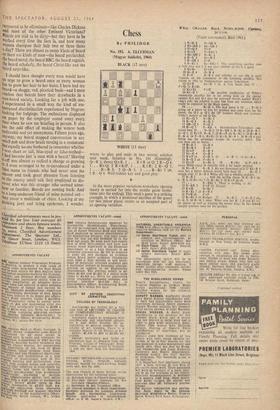Chess
By PHILIDOR No. 192. A. ELLERMAN (Magyar Sakkelet, 1964)
BLACK (12 men) WHITE (13 men) WIIITE to play and mate in two moves; solution next week. Solution to No. 191 (Gunning): Q—R 1, threat Qx R. 1 . . R xR or Q; 2 R—Q 4.
I... BXQ; 2 R XKIP. 1 . . . KxR; 2 R—Q 7.
1 . . . R—B 5; 2 Q—R 5. 1 . . . B--Kt 5 eh; 2 R—Q 6. Well-hidden key and good play.
In the more popular variations nowadays, opening theory is carried far into the middle game (some- times into the ending). This week's game is a striking example, in which a positional sacrifice of the queen for two minor pieces occurs as an accepted part of an opening variation.
SICILIAN.
(Team tournament, Bled 1963.)
P--K 4 P—QI3 4 2 Kt—KB 3 Kt—.
QB 3 3 P—Q 4 P xl
4 Kt XP P—KK1 3
5 Kt—QB 3 II--Kt 2 B—K 3 Kt—I1 3 7 11—(311 4 0-0
B—Kt 3 Kt—KKI 5. This simplifsing sacrifice loses a little tittle and it is not clear whether or not 'It is good. 9 Qx Kt KtXKt
10 Q—R 4 Q—R 4
11 0-0 B--I3 3 end whether or not this is gond depends on the assessment of the following sacrifice, first played in 1962 by Neshmetdinov against Tchernikov.
12 QXB Kt—K 7 ch. A little better than 12 . PxQ; 13 BXKt.
13 KtXKt PxQ
14 Kt—B 3 . . . the possible justification of White's remarkable sacrifice lies in his strong hold on the central squares Q 4 and Q 5 plus his awkward threats against Black's king's side: his position is also free from any looseness which might he exploited by the Black queen. 14 . . . R—K 1. The best Move is 14 . . , P—(;) 4 giving up a pawn to free his position and open lines for his pieces. On Q 2 or Q 3 the Q1' hampers Black and increases White's control of the Q file.
15 Kt—Q 5 K—Kt 2 16 B—Q 4 R—K 3
17 QR—Q I P—Q 3 18 R—Q 3 P—KR 4. NesismetdinoviTchernikov con- tinued here IR . . . R—Q 2; 19 R—KB 3, B--Kt 4; 20 B-11 3, Q—Q 1; 21 Kt x), B—K 7; 22 Kt xP eh, K--Kt I: 23 11—R 3. R.--K 4; 24 P—B 4. lixR; 25 Kxl1, it- 1: 26 B---q 4 and White has the advantage despite his material deficit. The test turns out no better.
19 B—B 3 Q-11 4
20 R—B 3 R xP
21 KtXP R—K 4 22 Kt—K 4 Q—B 3 23 R xP ch K—R 3. 23 . . . K -R I?; 24 Kt—B 6.
24 B—Q 2 eh P—Kt 4
25 Kt X P K—Kt 3. 25 . R xKt; 26 P—KR 4 leaves White equal in material with a far better position. 26 Kt—B 3 R—K 5. He was threatened with 27 Kt—R 4 mate but a better defence would have been 26 . . . R—Q 4 though after 27 R—B 8 White still has a winning position. 27 11—B 3 . . , with the terrible threat 28 R----B 6 ch, 1: T2 2; 29 Kt-- Kt 5 ch. K--Kt 2; 30 R xP
27 . . . R—KKt 5. There is nothing to do. 28 P—KR 3 R xP ch. Despair. 29 KxR 11—Kt 5 30 R—Kt 7 ch K—II 4 31 P XB ch P xP
32 R—Kt S ch Resigns 32. . . K—Il 5* 31 Q 2 K—K 5; 34 R- -K 1 mate. White now has R, 2 ii and Kt for the qteen—as well as winning the enemy king: he has Indeed • charged usurious rates for his sacrifice.


































 Previous page
Previous page